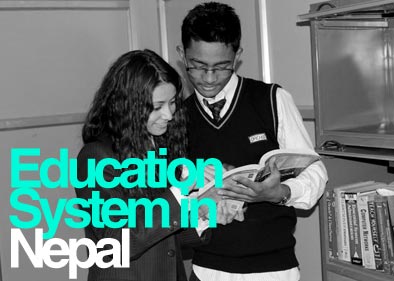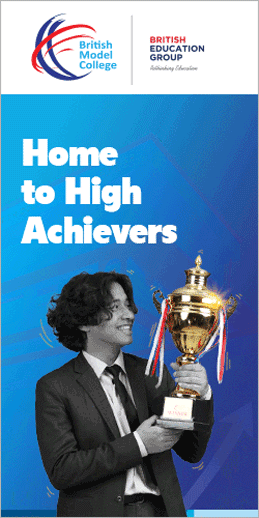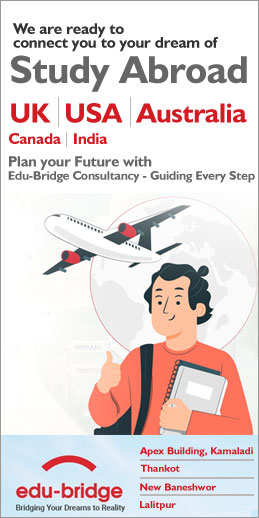Education System in Nepal

Education in Nepal from the primary school to the university level has been modeled from the very inception on the Indian system, which is in turn the legacy of the old British Raj. Hence, until the recent past, Nepal followed the traditional three-tier sixteen-year education system, allocating ten years to school education, four years to college level studies - two years each for intermediate and bachelor program, and two to the Masters program at the university.
During the 1950s and in the subsequent decades, Nepali students started facing comparative disadvantage in their academic and professional career advancement not to mention in the regional or international fields even in their home country. Therefore, in order to make the nepali education system more competitive and compatible, policy and structural changes were made and gradually implemented, although for the lack of funds and resources only at a snail's speed during the last three five year plan periods. As a result, the present education system although still in the transition phase, stands as follows:
(i) Pre-School Education
The pre-school learning, be it kindergarten, Montessori or any other form of pre-school education, does not yet form an integral part of the formal school education system. Nevertheless, the need for such facility is being increasingly felt by the society. And, a number of pre-school establishments have come into existence in response to the demand particularly among the affluent, the educated and the working parents in the urban areas. These facilities range from simple day-care centers operated by semi skilled tutors and ayahs to sophisticated but informal playgroups run by trained teachers and nurses, and from formal pro-primary schools managed as junior wings of large school set-ups to advanced westernized kindergarten and Montessori pre-school establishments. Very different in their fees and infrastructure, they profess equally diverse professional objectives and educational goals, and practice divergent approaches to early education. His Majesty's Government of Nepal has recently formulated some guidelines for pre-primary curricula.
(ii) School Education
(a) Primary Level
(b) Middle School/Lower Secondary Level (S.L.C.)
(c) High School/ Secondary Level
(d) 10+2/ Higher Secondary Level
Formal school education in Nepal officially spans a period of 12 years, at the successful completion of which a student graduates with a certificate of Higher Secondary Education (10+2). However, since the majority of the schools in the country have not been upgraded for the lack of funds and resources to the 10+2 level, the old high school system with School Leaving Certificate (SLC) examination at the end of 10 year still persists. Most of them are public schools funded by the government. However, they have not been able to reach and maintain the expected educational quality standards, nor have they been able to address the needs of the society. If the lack of adequate funds and resources is partly to be blamed, the lack of accountability and too much of politicization in the educational administration from the bottom to the top most hierarchy have had a crippling effect or the educational system. The S.L.C. examination results of the public schools, which have been getting bad to worse over the years, bear witness to this fact. Not surprisingly at all, in spite of tin provision of free education up to primary level and free distribution of books to girl-children and children of socially discriminated ethnic groups up to lower secondary level, parents prefer to send their children to comparatively more expensive private schools right from the beginning.
The private schools in general have better facilities, are better managed and have been showing a much better performance in the S.L.C. examinations. However, the quality standards of the private schools, too, are not consistent and vary considerably from school to school. There are, on the one hand 'A’ class private school establishments managed and run by charity organizations, companies, trusts or? visionary individuals, and on the other, the so called private English boarding schools operated by business minded people in semi-furnished residential houses or even factory-like tin-shades, which are in fact nothing more than teaching-shops. They do, nevertheless, seem to be catering to the taste and the need of the different sections of the society. In addition, the capital also has a British and an American School, which, although initially started for the children of the foreign diplomats, have opened their doors to Nepali children, too.
In the recent years, some public schools have upgraded themselves to the 10+2 level will governmental support, and in the urban and semi-urban areas a number of private 10+2 institution; have sprung up without any lower school base. This sorry state of transition to 10+2 level has forced the universities to continue their intermediate or proficiency certificate level program! for the time being, at least until 2005 according to the latest revised phase-out schedule. Hence,| present, the 10+2 level school education in Nepal is being administered parallely and independent by the university as its intermediate program and as a higher secondary school education program by the Higher Education Board of the Ministry of Education, HMG/Nepal. Meanwhile, the S.L.C Examination continues to remain as the iron-gate to be crossed for an entry into either of the above programs.
The SLC Examination System.
The SLC thus being the gate way to higher education commands full attention of all concerned-students and their parents, teachers and their institutions. The students are virtually groomed for the S.L.C. from s VIII onwards. They are taught the actual S.L.C. courses in class IX and X and are required to pass the qualifying examination, popularly called Sent-up Test, at the end of class X to be eligible to appear in the C. examination. The S.L.C. requires the students to take three-hour written examination of 100 marks in each subject for the entire syllabus covered in two years of class IX and X.
The evaluation scheme follows the traditional marking system with division ratings as follows:
35%and above to below45% - Pass with 3nd division.
45% and above to below 60% - Pass with 2nd division.
60% and above to below 80% - Pass with 1st division.
80% and above - Pass with distinction.
The S.L.C., however, as the policy makers claim, is now a matter of only a few years because after the full, nation-wide implementation of the 10+2 system, the present S.L.C. examination will be replaced by a or regional level class X examination. The Higher Secondary Education Board only will t national level 10+2 annual examinations to certify students of having completed their secondary school education or what is popularly called school education in the west.
|
Level |
Class/Grade |
Duration |
Pupil's Age |
Certifying exams |
Core Subjects |
|
Primary |
I to V |
5 Yrs |
5(+)-10(+) |
District level primary school examination at the end of class V |
Nepali, English, Math, Social Studies, Science |
|
Middle/Lower Secondary |
VI to VIII |
3 Yrs. |
10(+) -13(+) |
Dist. level lower secondary exam at the end of class VII |
Nepali, English, Math. Social Studies, Science, Health and Environment |
|
High School/ Secondary |
IX&X |
2Yrs. |
13(+)-15(+) |
School Leaving Certificate (SLC) exam at the end of class X |
Nepali, English. Math, Social Studies, Science, Health and Environment |
|
Higher Secondary 10+2 |
XI to XII |
2Yrs. |
15(+)-17(+) |
HSEB exams at the end of both XI and XII |
English. Nepali and 3 Core subjects of the chosen stream. |
(iii) Higher Education
(a) Bachelor's/Undergraduate Level
(b) Master's Level/Graduate/Degree Level
(c) Post Graduate, M. Phil. Level
(d) Ph.D. Doctoral Level
Higher education in Nepal, like elsewhere in the world, is the sole responsibility of and administered by universities and institutions of higher learning. At present, the country has six universities; five of these - two public (state), two again public (community) and one private - offer western model academic program and technical education while the remaining one, again a public university, is dedicated to the study of Sanskrit and related subjects. There are two more universities in the offing-an international Buddhist university at Lumbini and another a general university with concentration on BuddhisH at Banepa. But since they have not yet received the character, they can be classified only as proposed universities.
Entry into the public institutions of higher learning, except to the technical programs such as medicine, engineering, forestry and agriculture, remained and still remains to a considerable extent almost unrestricted. This has created a tremendous pressure on institutions, draining their physical and human resources and leading, in turn, to a progressive deterioration in the quality of education they impart. As a result, during the last decade of the last century, the government has granted affiliation to a number of private i.e, proprietary colleges and many of them are now fully operational. They offer their programs with the same curricula, but being smaller in size and restrictive in enrolment, they are better equipped and better facilitated. However, such colleges are comparatively very expensive and are almost beyond the reach of the common people. Similar is the case with the only private university of the country as its programs, too, are accessible only to the family well-off.
|
Institute |
Estd Date |
Type |
Number of Campus |
Major Field of study |
Degrees offered |
|
Tribhuvan University |
1959 |
Public (State) Residential cum Affiliating |
61 own |
Humanities and Social Sciences, Management, Education, |
Intermediate Bachelor's Master's M. Phil. Ph.D. |
|
Kathmandu University |
1991 |
Private (UGC grants) |
Central Campus + 8 Affiliated Campuses |
Management, Science, Arts, Education, Engineering and Medical Sciences. |
Intermediate Bachelor's Master's M. Phil. Ph. D.** |
|
Purbanchal |
1995 |
Public |
2 Univ. |
Sciences Technology, Management, Humanities, Law and Education |
Bachelor's Master's M. Phil.** Ph. D.** |
|
Pokhara University |
1995 |
Public |
Central |
Management, Science & Technology, and Humanities & Social Science |
Bachelor's Master's M. Phil. Ph. D.** |
|
Mahendra |
1986 |
Public (states) Residential cum Affiliating |
Central |
Sanskrit, Ayurved and Related subjects |
Intermediate Bachelor's Master's Ph. D. |
|
B,P. Koirala Institute of Health Sciences |
1991 |
Public (state and donor grants') Residential |
Central Campus |
Medicine and Health Sciences |
Diploma Bachelor's Master's Doctoral |
source: Nepal Educational Directory
Posted on: 2010-12-01





























